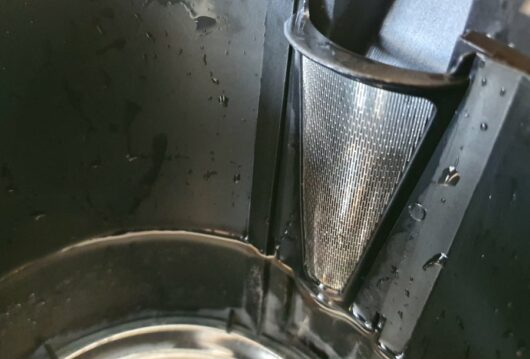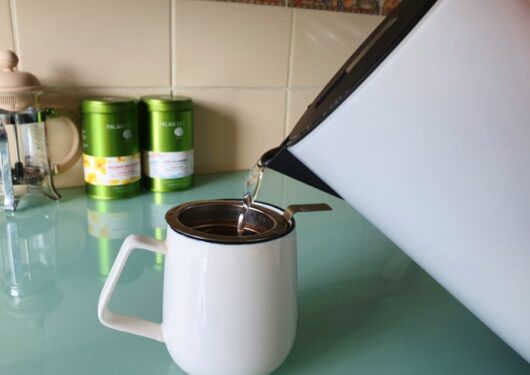
Ritter Kettle Review - Fontana 5
It is not easy to find an electric kettle made in Europe, there only a handful of makers based in Germany, UK and Italy.
Ritter, a small and young company from Germany who makes household and professional kitchen equipment surprised me with their take on what the modern electric kettle should be like.
I owned this Ritter Fontana 5 kettle for over two years now, and finally I found the time to share my thoughts on it with you.
Overall Impressions
I look at my kettles from three main perspectives: design, functionality and, of course, the story behind it.
This beautiful kettle has moved with me three times now, every time to a very differently designed kitchen. And because it is stylish but not 'too much in your face', I felt it fit into a contemporary and more rustic kitchen interior.
Functionality is the main reason that won me over other kettles. It is cordless, fuss-free to maintain and, most importantly, has an adjustable temperature. As a green tea drinker, I boil water at 70° C (158 F); hence it is a must-have for me.
From the story perspective, it was great to support an innovative company/manufacturer from Germany, Munich - a city that I adore, and not just for its October fest.
A Quick Story About Ritter
Ritter or, in its full company name Ritterwerk GmbH, was born in the suburbs of Munich. Its founder Franz Ritter created a company together with his son and called it 'F. Ritter & Sohn'.
They designed and patented a unique machine called 'Bürsten-Messerputz-Maschine' ('brushes knife-cleaning machine') that automated cutlery cleaning from rust. Those were the days before stainless steel cutlery became mainstream. Hence, despite disruptions during WWI, it made more than 100,000 such machines by the 1920s.
Today the company is no longer with the family, as it was sold to the owner of Braun GmbH in 1969. As an independent brand, Ritter is currently known for its innovative design-led by Martin Dettinger and making all of their household appliances in Germany.
You might have come across the Ritter brand name on several product design awards; without going into all of them, this kettle has been recognised by iF Design Awards and Blue Angel Awards (twice) for its design and innovation.
Although the company with its 150 employees is now in Gröbenzell, for 70 years it was a significant part of Passing town (between 1912 - 1980). Hence the former factory is now turned into a cultural centre hosting a restaurant, bar as well as concerts and events - look it up if you plan to be near Munich - Pasinger Fabrik.

Temperature Control
The Ritter kettle has the temperature adjustment feature, which is very easy to use - essentially, these are four separate buttons to start heating the water. It shuts off automatically once it reaches the chosen tier.
I find it very useful when drinking my loose tea mixes, especially when enjoying more temperature-sensitive green teas from China. I am sure anyone who is into tea drinking will appreciate this feature.
Even my girlfriend, who just drinks black tea, has now started boiling her water to 80° or 95° so she can drink it straight away without the need to wait for it to cool down. Also, it heats up faster this way and consumes less electricity - a feature really appreciated by the more eco-conscious people.

Boiling Speed And Noise Level
It is fascinating that, according to Which (a UK consumer advice body), some kettles can reach the noise level of 95dB, which is louder than the drill (an article from The Telegraph).
Ritter Fontana 5 kettle reaches up to 65dB for about 10 seconds, just before boiling point, which is considered a conversation noise level.
In terms of boiling speeds, I am really impressed that to boil 0.75 litres of water, it takes 1 m 33 s, in comparison to 5 m 53 s, to boil the same amount of water in the pan on the gas stove.
To reach the lowest temperature setting of 70° C, it takes only 1m 4 s.
Cleaning
As we all know, the reality is that you can have as many filters as you want; eventually, the kettle grows limescale and hence cleaning is an important factor when owning a kettle.
I owned a fancy copper kettle on which I could not use any cleaning materials with acid, and believe me, that made my life quite a bit more complicated than it needed to be.
This kettle is not sensitive to any cleaning materials, and just half an hour in vinegar usually does the job.
I especially like the stainless steel limescale filter/grill. It prevents limescale from flowing into the cup, and I can easily remove it when cleaning.
Handy Design Features
I like the design of this kettle as it seems that the Ritter design team thought of a lot of small details.
Just like that, I can open the lid with one finger by pulling a lever on the top. It springs the cover to open slowly, without danger of small splashes of boiling water.
It is also lovely to have such a wide opening across the kettle's entire diameter, making it easier when pouring water in and cleaning the inside.
The handle is sturdy and easy to grip. Not much else to highlight, apart from the fact that it is reliable with zero risks.
The snout is not that prominent but wide enough to pour large volume if needed and have a steady stream when pouring slowly.
The Swivel Base For Cordless Kettle
It is a pretty standard, but nevertheless, convenient cordless kettle base. It is very steady and easy to place the kettle on. I like that I can swivel my kettle 360°, which is nice when checking the water levels or changing the hand I use to pour the kettle.
There are some other thoughtful design features like cord storage at the bottom. The electric socket is very close to the kettle in my current kitchen, but I don't have a cord just taking the space on the worktop - it is neatly folded underneath.
Also, there are two cord wholes at the base, allowing you to choose which side the cable is to come out. It can be important when using the temperature controls, which sits on the base itself and does not turn.

Made in Germany
As part of the itisMadeinEurope.com team, I am discovering European makers as I go about my ordinary daily life. But at the same time, I hold any item I buy to the same requirements and personal values just like before.
Hence, for me, the fact that it is made in Germany was only a starting point. I still was quite critical and attentive when trying to decide whether I should buy it or not.
But I have to say that it did not disappoint me. After using it for a while now, I can see that it meets my expectations for German quality and opens my eyes to small details that can make your life a little easier every single day.
----
Since this Ritter kettle review is based on my personal experience and opinion, I am sure other readers will agree that it would be great to hear what others thinking too. Leave your thoughts and opinions in the comments bellow.
Please note that this site uses affiliate links to support the costs of maintaining and further developing the site. Full Privacy Policy.
One email every three months. No spam - just interesting discoveries.
What Italy makes is a multi-layered story. Learn more about Italian manufacturing, design and trends.
If you like Ritter kettle, you might like their toaster too.
Here is a quick video review.
It is called 'Big Corkscrew' for a reason. Its Italian craftsmanship is impressive; and this thing is huge.
Discover rare and unique – kettles made in Italy, France and Germany. You have quite a few to choose from.













